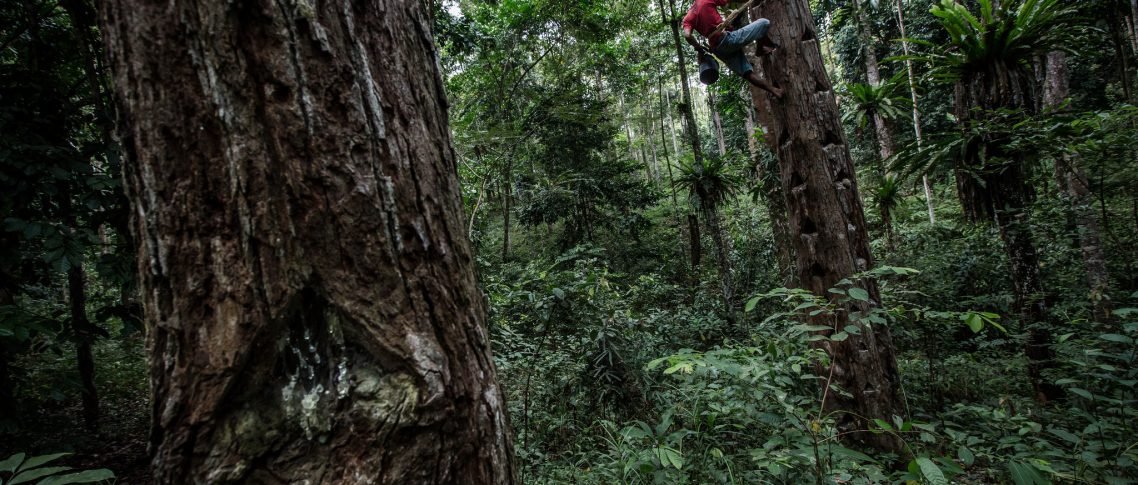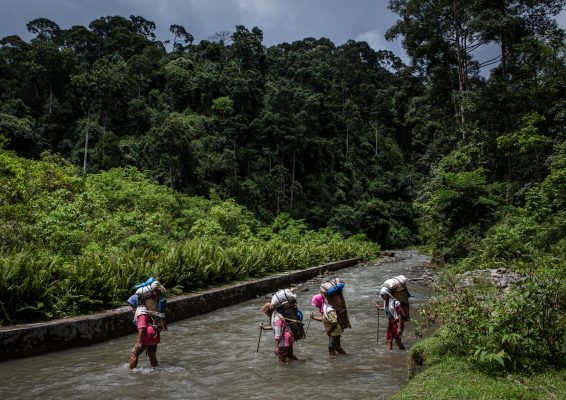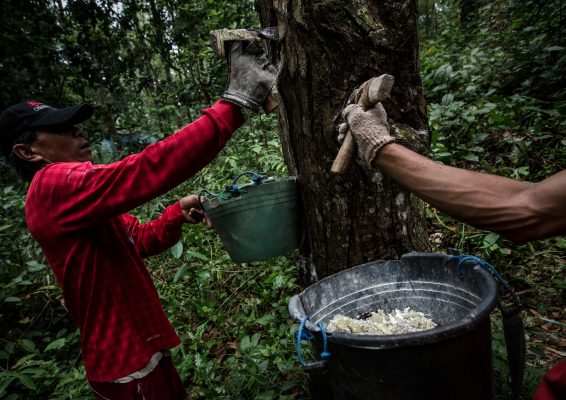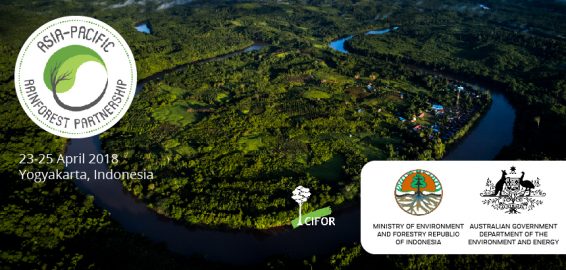Dedy Aprianto packs his gear and begins walking from his home in Pahmungan village in Indonesia’s Lampung Province. A few hours later, he reaches a small one-square-meter hut in the forest and takes out his supplies.
He starts clearing the undergrowth below a damar tree on which he’ll be working. With only a woven rattan belt as a harness, he steps onto the triangular niches hammered into the tree during past harvests to collect the damar’s sap, which goes into products ranging from food to varnish and incense. Using the old niches as footholds, he climbs up the tree to carve new nooks.
The people of Pahmungan, a small village adjacent to Bukit Barisan Selatan National Park in the southwestern tip of Sumatra, have used damar as their main source of income for more than a century.
“This tree is about 50 years old,” says Aprianto. “It was handed down for generations. This is our family’s land, and damar is the main source of livelihood for our community.”
However, the land has been a place of contention, as governmental changes to land status have clashed up against customary tenure practices.
For this reason, researchers from the Center for International Forestry Research (CIFOR) investigated tenure insecurity issues here as part of the Global Comparative Study on Forest Tenure Reform (GCS-Tenure).
“Pahmungan village was chosen as one of the research locations because of its issues linked to community rights,” says CIFOR Scientist and project coordinator Tuti Herawati. “Certainty over land in the village constituted an important subject matter for learning.”
What the scientists found was that implementation of social forestry schemes could be the answer to the latent challenges.

ON THE BORDER
Damar (also spelled dammar) comes from various dipterocarp trees – tall and thin hardwoods, often barren of branches until the very top. Native to tropical lowland rainforests, damar trees live throughout Indonesia, as well as in other parts of Southeast Asia.
“Repong damar was managed by the community and handed down from generation to generation,” says Herawati about Pahmungan’s damar tree work areas (repong damar). “But in the 1990s, this area was delineated as State Forest Area.”
In 1991, the Indonesian government changed the status of these damar forests to state-owned limited production forests, sparking resistance from the community and threatening their livelihoods.
Eventually, the Ministry of Environment and Forestry listened. In its Special Decree No. 47 of 1998, the Ministry designated around 29,000 hectares of repong damar within the limited production forest in West Lampung Regency as a Kawasan dengan Tujuan Istimewa (KDTI), or ‘Special Purpose Area’.
As a KDTI, the forest’s status remains state-owned, but its management is given to local people, so they can continue their repong damar practices.
However, despite management abilities, the villagers lack the tenure security. They fear that the government could at any point change the land status again, causing them to lose access to the forest and their source of income.
This insecurity also sparks disputes over the boundary between the KDTI and the limited production area.
“The limited production forest in Pesisir Barat Regency is around 33,350 hectares, and part of it borders directly with the community’s repong damar,” says Enny Puspasari from the Lampung Province Forestry Office.
“To resolve these various tenure conflicts, I believe that social forestry schemes are the best solution for Lampung,” she says.


PRICE POINTS
During damar harvests, a group of women can be seen filing through the forest, braving bridgeless rivers and streams with heavy bags on their backs.
This is part of the local economy: damar farmers like Aprianto pay village women to carry their harvested resin back to the village.
Dahniar is one of about a dozen of these women. “I get paid 600 rupiahs [approximately USD 0.04] for every kilogram,” she says. “Sometimes I can bring home only 15,000 rupiahs [USD 1.10], but there are days when I can earn up to 50,000 rupiahs [USD 3.65] for two trips in a day.”
The researchers found that around 60% of the community relies on repong damar for income.
But the economy is not stable. Without proper land rights, the community lacks bargaining power to set the price of damar sap and keep it from fluctuating. This puts not only local livelihoods but also the forest at risk, as it can lead to the felling of trees for extra cash.
Outside help is beginning to step in. Local environmental NGO Watala Lampung not only helps the community manage repong damar sustainably but it helps educate villagers on the benefits of social forestry and provides platforms for government engagement, to promote the importance of repong damar.
“Watala’s role is to bridge communities between all parties – not only colleagues in Lampung, but also across the nation on how repong damar can be preserved for the future, because there are many challenges when it comes to managing repong damar in Lampung,” says Rini Pahlawati, staff at Watala.
Social forestry, she agrees, could be the solution.
Read part one of this story, Why social forestry: Keeping the coffee.
We want you to share Forests News content, which is licensed under Creative Commons Attribution-NonCommercial-ShareAlike 4.0 International (CC BY-NC-SA 4.0). This means you are free to redistribute our material for non-commercial purposes. All we ask is that you give Forests News appropriate credit and link to the original Forests News content, indicate if changes were made, and distribute your contributions under the same Creative Commons license. You must notify Forests News if you repost, reprint or reuse our materials by contacting forestsnews@cifor-icraf.org.
